
 |
August 16 - Around the World
In the August Changes,
we reported on the adventures of 'Lonesome Roy' Wessbecher of
Santa Clara. As you might recall, Roy purchased a Columbia 34
MK II for $20,000, then sailed around the world for nearly five
years on a total monthly budget of less than $500. Another interesting
feature of his trip is that he had 18 crew - 17 of them women.
In fact, here's a little gallery of some of the girls. Tune in
to the September 'Latitude'
when not-so-lonesome Roy explains how he found them and the best
way to sail with them.
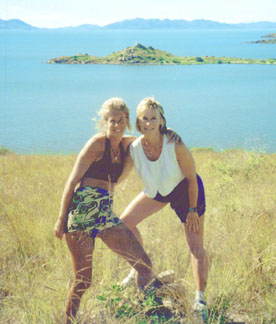 |
 |
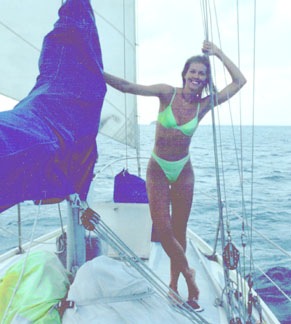 |
 |
 Photos Courtesy Roy Wessbecher |
|
Weather UpdatesAugust 16 - Pacific Ocean San Francisco Bay WeatherTo see what the winds are like on the Bay right now, check out http://sfports.wr.usgs.gov/wind/. It's a great time of year to be sailing the Bay. California Coast WeatherLooking for current as well as recent wind and sea readings
from 17 buoys and stations between Pt. Arena and the Mexican
border? Here's the place - which has further links to weather
buoys and stations all over the U.S. Pacific Ocean WeatherCheck out the weather map at right. |
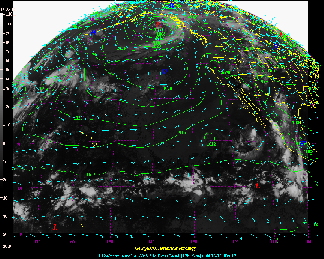 University of Hawaii Meteorology Graphic |
Seas are relatively normal in the North Pacific except for
the last several hundred miles coming into San Francisco from
Hawaii.
Have a look at http://www.mpc.ncep.noaa.gov/RSSA/PacRegSSA.html.
For another view, see http://www.oceanweather.com/data/global.html.
Alberto, the first Atlantic hurricane of the season, has been
a 12-day beauty. While down to 40 knots of sustained wind from
hurricane force, she's done a complete 360-degree turn in the
middle of the Atlantic. Check out her chart.
Meanwhile, in the Eastern Pacific, Hurricane Hector and Tropical
Storm Ileana both continue to blow well off the coast while heading
for the open Pacific. The Mexican hurricane season has been as
busy as the Atlantic's has been quiet, but all the hurricanes
have started and continued well offshore.
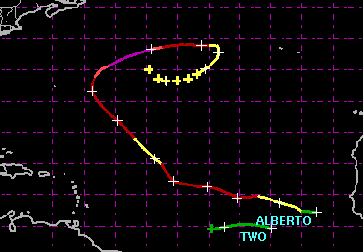 Hurricane Alberto |
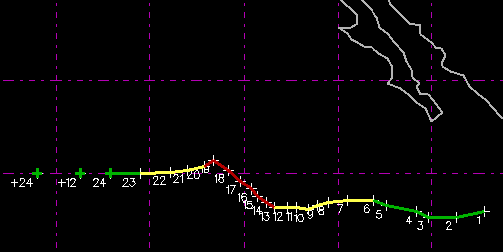 Hurricane Hector |
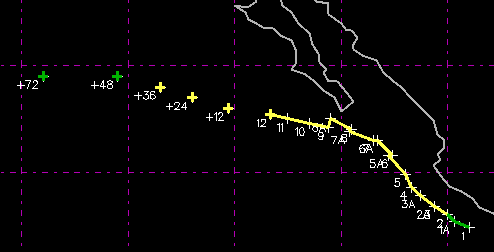 Tropical Storm Ileana |
See http://weather.unisys.com/hurricane/atlantic/2000/index.html and http://weather.unisys.com/hurricane/e_pacific/2000/index.html for more.
August 16 - San Blas Islands
It could be a record - although a somewhat dubious one. Canadians Ken (last name unknown) and Karmella Beemer departed San Diego on May 8 for the South Pacific aboard their 29-foot custom aluminum sloop 'Karmella', and didn't arrive at Bora Bora until August 12. That means they were at sea for an astounding 96 days! Normally a passage like that might take a month or even five weeks. The reasons for the particularly long passage aren't clear, although it's known they didn't lose their rig or rudder. Weather seems to have been a factor, as they reported having one good day of sailing out of San Diego, followed by 95 bad ones with wind on the nose. This, however, would be most unusual. The small boat was heavily loaded, which didn't help the speed, but at least they didn't run out of food. Apparently squalls augmented their water supply. It was also reported that they overstood Bora Bora - which means they must have sailed by both the Marquesas and Tuamotus - and had to be towed to land by a French Navy vessel. We'll try to get more on this story.
August 16 - The Pacific Ocean and Cyberspace
Who is out making passages in the Pacific and what kind of weather are they having? Check out YOTREPS - 'yacht reports' - at http://www.bitwrangler.com/yotreps/
August 16 - Pacific Ocean
| While the details are unclear, there has been
a serious accident aboard one of the many West Marine Pacific
Cup yachts being delivered back to the mainland. Lani Spund's
Santa Cruz-based Santa Cruz 52 'Kokopelli 2' was dismasted, apparently
over the weekend. One of the crew was knocked unconscious and
suffered a punctured lung. The crewmember's name is not known.
'Kokopelli's crew was apparently able to contact a Portland-bound
ship, which took the injured crewman until they were within helicopter
range of shore. The injured crewman was then picked up by the
Coast Guard and taken to a Portland hospital. His condition is
unknown. It's likely that the dismasting destroyed 'Kokopelli's SSB antenna, so they have not been able to contact the owner directly. The boat's position is also unknown, although a posting on today's Pacific Cup site puts 'Kokopelli 2' at 475 miles from San Francisco. She is reportedly rendezvousing with another boat, presumably to take on fuel. It's not known how many crew are left on the boat or if any of them are injured. 'Kokopelli 2' is the second Pacific Cup boat to have been 'hit by a gravity storm'. Steen Moller's X-119 'X-Dream' dropped her rig two days out of Hawaii and returned to the Ala Wai Yacht Harbor. Moller was last seen looking for Matson Lines. |
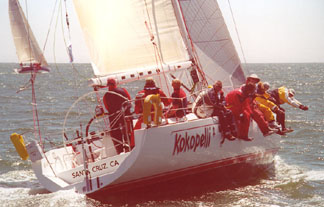 'Kokopelli 2' Starting the Pacific Cup Latitude Photo |
August 16, 1:00 PM PDT - Alameda
On August 10, the Coast Guard received a 406 MHz SARSAT alert
located 1,000 miles west of San Francisco for an EPIRB belonging
to a 52-ft Santa Cruz sailboat. Due to the distance offshore,
this case was coordinated by the Coast Guard Rescue Coordination
Center located in Alameda, CA. The Coast Guard launched a C-130
long-range search plane from Air Station Sacramento which located
the dismasted sailing vessel with five people on board, one of
whom had been injured by the falling mast. The Coast Guard also
used the Automated Mutual-Assistance Vessel Rescue (AMVER) system
to locate a nearby commercial petroleum tanker and asked the tanker
to assist. On August 11, the injured person was transferred to
the tanker and the tanker was able to transfer fuel to the dismasted
sailing vessel before continuing its transit to Portland, OR.
At the request of the Coast Guard, four para-rescue jumpers from
the 939th Air Force Reserve Squadron were deployed to the tanker
to stabilize and evaluate the patient for possible medical evacuation.
On August 12, the injured man was hoisted by air-refuelable helicopter
600 miles south west of Portland, OR, and delivered to Emanuel
Hospital in Portland. The dismasted sailboat is scheduled to rendezvous
with a fishing vessel on August 17 to take on additional fuel
required to make land-fall. A quick note: AMVER is a completely
voluntary vessel tracking system where merchant vessels report
their location and intended tracklines to the Coast Guard to assist
mariners in distress. When called, they often divert to render
assistance to vessels hundreds of miles away at significant cost
to the parent company. The AMVER system and the generosity of
the participating companies is responsible for saving scores of
lives each year by directly assisting mariners in some of the
most remote locations of the ocean.
Top / Index of Stories
/ Subscriptions
/ Classifieds
/ Home©2000 Latitude 38 Publishing
Co., Inc.